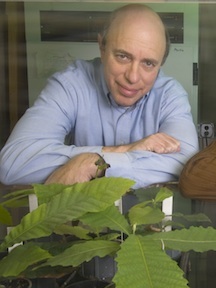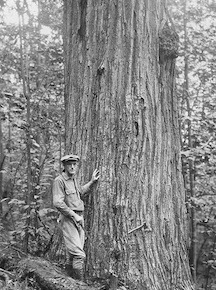
By Hayden Field
The American chestnut tree dominated the Appalachians. Before the mid-20th century, it was not at all uncommon to spot its trunks reaching towards the sky or catch a glimpse of its long, almond-shaped leaves while walking in the woods. Deer, bear, wild turkey, and many other animals and insects depended on the chestnut to produce a dependable crop of flowers and high-food-value nuts every year that were never in danger of being lost to a late frost. But in the 1880s, all that began to change: there was a new face on the horizon in America, and its name was chestnut blight. A villain who hitched a ride on trees imported from Japan, where resistance had rendered it essentially useless, chestnut blight had its sights set on weakening the strong forest foundation that the American chestnut had worked so hard to produce, and it wasn’t going anywhere until it took that tree down for good.
By the early 20th century, the battle had shifted in chestnut blight’s favor. By the 1950s, it had infected virtually every American chestnut. The chestnut blight fungus gives off spores that find their way into cracks in bark or other wounds in the tree, start growing under the bark, and employ oxalic acid to kill and eat the living tissue underneath the bark. The end result? A complete ring of dead tissue around the once-strong American chestnut.
Since the American chestnut had ruled the Appalachians, there was now a leadership vacancy that no other tree was prepared to fill. Oak trees began to decline because they weren’t ready to fill the gaps left by their predecessor. Along with the disappearance of the American chestnut went the food it faithfully produced, and there are stories of declines of animal and insect populations like the wild turkey, bear, and moth.
Enter Scott Merkle (ΦBK, College of William and Mary, 1975), associate dean of research and professor of forest biology at the University of Georgia’s Warnell School of Forestry and Natural Resources. Although his job has a propensity for complicated words, it really all boils down to one thing: “breeding” living tree cells in an artificial environment.
Merkle started working to free the American chestnut from its nemesis in 1989, when he wanted to propagate (“breed”) trees and remembered all he’d read in graduate school about American chestnut and chestnut blight. He discovered that no one had yet reproduced it successfully in tissue culture (an artificial environment). Ever since, he has been collaborating with other American chestnut specialists attempting to produce new strains of the tree that are already blight-resistant—the same type of resistance that Chinese and Japanese chestnuts have built up over centuries. Chestnut blight thinks it’s won once and for all against the American chestnut, but Merkle’s research has focused on incorporating a succession of different genes into tissue cultures to see which one might finally turn the tables.
In the beginning, it was hard for Merkle and his team to find chestnut trees large enough to produce nuts in Georgia. And since the nuts are too mature to produce any results if they’re already on the ground, they took to pruning poles and ladders in the mountains to get the nuts right off the trees in August. Merkle traveled to locations all around Georgia like Brasstown Bald, sometimes following word-of-mouth rumors of American chestnuts, only to find out that someone had been mistaken. “This kind of project has lots of bottlenecks and hurdles,” he says.
For over a decade, Merkle and his team struggled with setback after setback—the structures that the tree cells formed when put onto different mediums wouldn’t germinate; the structures wouldn’t respond to any of the many different treatments; the plants would die once potted; they needed different soil mix, fertilizer spray, and countless other hurdles.
“You have to pay attention to them all the time,” he explains. “They’re the worst ‘babies’ of any of the systems we’ve worked with. They’re very demanding.” They finally decided to hire someone full-time to take care of the plants because they required such intensive work each day.
“The real turnaround was when we could show that we could transform things and regenerate them,” Merkle says. “Because once we got that, we knew we could test any gene that anyone gave us. That was the breakthrough.”
One gene shows promise in making the trees blight-resistant, and that’s oxidase oxalate. It creates an enzyme that breaks down oxalic acid, which is chestnut blight’s most valuable weapon against the American chestnut. The lab at the State University of New York’s College of Environmental Science and Forestry has been working on this gene for twenty years. William A. Powell, with whom Merkle collaborates, inserted the gene into American chestnut to slow the progress of the chestnut blight fungus enough that the tree will be able to fight it off. The trees that Powell sent Merkle seem to be doing well and are about three feet tall growing at Whitehall Forest in Athens.
Merkle and his team are still trying other genes, some from the Chinese chestnut, which are much closer to the American chestnut genome and can be crossed by breeding naturally, as well as some from other organisms. The team has recently sent about 300 trees with different genes to Virginia Tech to be planted on field sites in the mountains for study.
“I’m sure the people who are concerned about it feel that there are dangers in genetic engineering because the process is not natural,” Merkle says.
Merkle continues:
“That is one way to look at it, but the other way to look at it is look at one gene you’re actually putting in there instead of how it’s getting in there. It’s in wheat — every time you eat a peace of bread, you’re consuming oxidase. There’s no real concern. Sometimes you can put a gene, and it’ll change a gene that’s already there, [but there are] years of testing on trees before anything is given non-regulated status… You can never, no matter what anyone tells you, prove that anything is completely safe because you can’t prove a negative… But with enough testing you can reduce the chances of a negative impact to tiny, tiny numbers.”
Merkle says he’s not at all certain that freely planting transgenic trees will ever be approved without very strict regulations. Powell from the SUNY-ESF lab is currently working very hard to get his oxidase oxalate trees to non-regulated status by way of the USDA, EPA, FDA, and others, and Merkle estimates it’ll be about five years of battling to get planting approval. If Powell gets approval for his trees, Merkle and his team will continue to collaborate with him as they have been doing for almost ten years now. They will put the genes into Georgia chestnuts since the SUNY-ESF lab trees are adapted to New York and also fight for approval.
“If that happens, the change to the ecosystem that you’re going to see will be relatively slow at first,” Merkle explains. “Landowners will have to plant them; numbers will be limited for a long time… but once those trees start growing up and making pollen, they’ll produce a lot of nuts, the pollen will carry those oxidase trees.”
“The offspring from those pollinations will have the resistance genes, and eventually, the idea is that chestnut will resume its position in the mountains as a dominant tree… But it’ll probably be a few hundred years before you see big stands of chestnut again,” Merkle says.
For now, Merkle is doing his best to arm the American chestnut with a gene that it can employ as its secret weapon against chestnut blight. Just when the blight thinks it’s in the clear, the American chestnut will hopefully rise like a phoenix from the ashes, ready to dominate the Appalachians once more. “This research part of this has been so much fun,” Merkle says. “There’s nothing I’d rather do.”
Hayden Field is a senior at the University of Georgia majoring in journalism and theatre. She’s the editor-in-chief of UGAzine, her school magazine, and hopes to one day make the world a better place by sharing its untold stories. The University of Georgia is home to the Alpha of Georgia Chapter of Phi Beta Kappa.
Photos: (Top right) Scott Merkle (ΦBK, College of William and Mary, 1975), associate dean of research and professor of forest biology at the University of Georgia’s Warnell School of Forestry and Natural Resources. (Top left) American chestnut tree, West Virginia, 1924. Forest History Society, Durham, North Carolina.




